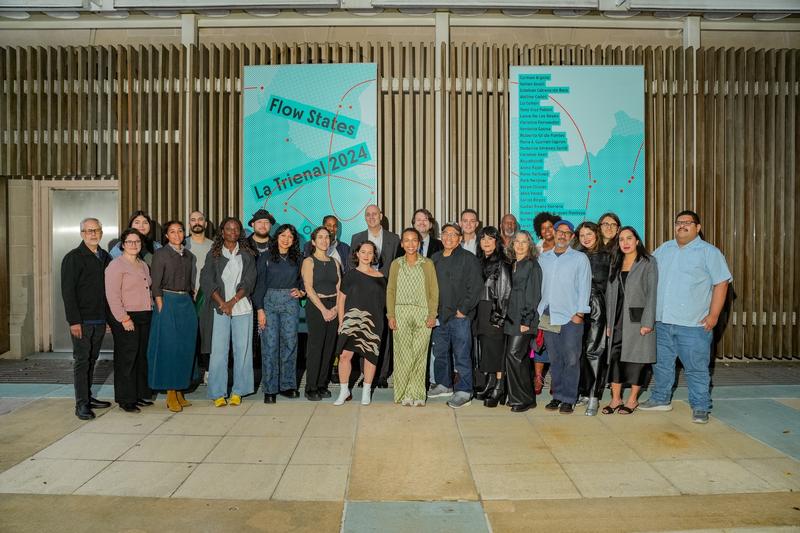Alison Stewart: This is All Of It on WNYC. I'm Alison Stewart. A new show at El Museo del Barrio features 33 artists exploring geographic boundaries, the diaspora, and a cultural exchange. The show is titled Flow States LA TRIENAL 20244. Building off the critically acclaimed inaugural survey of Latinx contemporary art in 2021, the new show includes work from artists from places like Phoenix, Arizona, San Juan, Puerto Rico, but also Glasgow, Scotland, and Berlin, Germany. Flow States LA TRIENAL is on display through Sunday, February 9. Two of the curators are here to discuss. Susanna Temkin is the curator for El Museo del Barrio. Hi, Susanna. I can see you on the other side. Also welcoming us is guest and curator of Museum of Modern Art from Fort Worth, Texas, is Maria Elena Ortiz. Maria, nice to meet you.
Maria Elena Ortiz: Nice to meet you. Great to be here.
Alison Stewart: As we're talking about this show, this title of it, Flow States. What does it mean?
Maria Elena Ortiz: Flow states? In psychology, being in flow, it's when you are one in-- You're in the zone creating. Like, think about Tom Brady, an athlete. In sports, it's very commonly used in those terms. Here in art, we're taking a similar approach in which these artists are just in the flow, in meditative state, creating artwork, and they're each of their own in the flow, and together they generate multiple states of creation.
Susanna Temkin: Yes, and we added that as to the state because we are, as you said, at the top of the show. We're really interested in exploring geographies and going beyond regular boundaries or borders and exploding them states, pluralities, multiplicities at the heart of the artists that we're showing.
Alison Stewart: What specific goals did you have for this show?
Maria Elena Ortiz: First goal is celebrate Latinx artistic practice. That's really one of those artists that are not usually represented in museums and exhibitions. We really wanted to hone in on the range, creativity, and tenacity that these artists brings to the table.
Alison Stewart: Let's talk about the selection process. Includes painting, sculpture, photography, filmmaking. Tell us a little bit about the selection process of the 33 artists.
Susanna Temkin: Well, Maria Elena, myself, and Rodriguez Mora, we've been working together for over two years, and during that time, of course, we were going to museums, exhibitions, galleries, but also we ended up doing over 80 studio visits, just one on one meeting with artists, getting to know their practices.
Alison Stewart: That must have been kind of fun.
Susanna Temkin: Super fun.
Maria Elena Ortiz: The best part.
Alison Stewart: Isn't it, right?
Susanna Temkin: Yes. Really getting to know the state of the field today. There's just so many Latinx, amazing artists doing, I think, some of the most exciting contemporary art out there.
Alison Stewart: You're talking about outside of what people would consider Latin communities, you're talking about around the world. Why did you want to make it the diaspora?
Maria Elena Ortiz: Because we're all one big Latin community. I think that it doesn't matter where you are in this country. If you're Latin, you have family somewhere else, or you've been somewhere else for part of your life. We wanted to really acknowledge that migratory experience of our culture. That is what also makes us so unique that we're a little bit of everything.
Alison Stewart: Did you want to add something?
Susanna Temkin: Yes, I mean, and even we also invited artists who might not identify themselves as Latinx, like Mario Martinez or a Norberto Rodan. Maybe as you-- I just said their names, and that makes you think, like, wait, you guys are not Latino? Not Latinx. It speaks to these larger histories that we share, histories of imperialism, of colonialism globally, whether that's in the Philippines or in the southwest United States. Mario is from the Yaqui indigenous community there, predating any of these terms, which, of course, themselves are so porous.
Alison Stewart: We're speaking to curators Susanna Tempkin and Maria Elena Ortiz about the new show, Flow States, LA TRIENAL 2024, on display at the El Museo del Barrio through Sunday, February 9th, 2025. It's weird to say that. Let's talk about a different artist, Kathia St. Hilaire.
Maria Elena Ortiz: Yes, Kathia St. Hilaire.
Alison Stewart: She uses really cool things in her artwork. She uses, like, banknotes and lightening cream and aluminum and steels. How does this add an interesting element to her work, aside from what we see with our naked eyes?
Maria Elena Ortiz: Yes. I mean, so she has a very labor-intensive practice. She was born in Palm Beach, and she belongs to that beautiful Haitian community of south Florida. She very much in her work, when you see it, yes, it's like a magical realism with a lot of Haitian voodoo and Haitian histories. Then what she does with the actual work is that she's using skin-lightening cream, she's using steel, and we all know the politics of all those components. By using that, she's always empowering her own history and her own narrative, which is very compelling.
Alison Stewart: In the first gallery, you have a neon sign, which is a piece from-- I hope I say his name right. Chaveli.
Susanna Temkin: Chaveli Sifre.
Alison Stewart: Thank you. A Puerto Rican artist based in Berlin. Tell us about the sign, what the neon sign depicts.
Susanna Temkin: Well, Chaveli also is part of this flow. She's based in Berlin but from Puerto Rico. She's Boricua. She's an artist who's really interested in scent and olfactory practices. We have a neon sign of lungs, which, of course, it's through respiration that we get that sensory element. When you come, you'll see or you'll smell, I should say Caribbean colada, the little trees, those little car ornaments, deodorizers.
Alison Stewart: You can take them with you, yes.
Susanna Temkin: You can take one with you, but together we're having that breathing in, breathing out moment as we walk through her commission.
Alison Stewart: In one of the back galleries, Elena Perez has a large charcoal drawing called Family Romance. What does the piece depict?
Maria Elena Ortiz: The pig is a beautiful drawing. That is a large-scale drawing in which you see different figures, almost a family setting, with the pig being roasted in the background, which a lot of us can, just hearing that, want to taste the pig. There's also on the corner a child non-consenting to abuse. Really is a very powerful image that speaks about the toxicity that happens sometimes in our families. Ideas of consent. Very much thinking about the power and the patriarchy, how sometimes these things are happening around our families, and we either stay quiet or look away.
There's a lot about silencing, silencing family trauma. It's quite brave for the artists to share that because it's part of their personal story with our audiences.
Alison Stewart: What do you like about her charcoal drawings? They're kind of unique.
Susanna Temkin: I mean, for me, her work is one of the tour de forces in the show. It is a drawing, but it almost has a luminescent quality, the way she's really able to manipulate these deep shadows, also letting the whiteness of the paper shine through. It's an allegorical painting, so there's so many details you see, like the spilled beer, the dominoes, the lechon that Maria Elena already spoke about. It's just, I think one of the-- Just a magnificent work of art.
Alison Stewart: We're going to talk about a piece by Garia Rivera Herrera.
Maria Elena Ortiz: Yes.
Alison Stewart: Based out of St. Juan, Puerto Rico. My Spanish coming in, it's objects that are arranged on the table. Will you explain how the objects are arranged?
Maria Elena Ortiz: Yes. For that work, it's three tables that have an arrangement of artist books and also ceramics. You see different ceramics in terms of the use of materials that he's using, and he's very much thinking about the connections between his own Afro-diasporic experience. He spent a little bit of time in West Africa, also in New York, and, of course, born and raised and still lives in Puerto Rico. For example, in one of the artist's books, there's a picture of people on a train. That was inspired when he was living in New York, and he would take the train to go to work. He would look around, and everybody in the train was Black like him. He felt like, "Oh, we're all like the same community, the same people."
It's very much kind of looking at those Afro-diasporic connections.
Alison Stewart: When you think about the TRIENAL, it was said in the paperwork for it, the first of its kind in the United States. What does that say to you?
Susanna Temkin: I think that's what Maria Elena was speaking to earlier. Latinx art, it's having a great exciting moment. We have more colleagues in all of the mainstream art museums, and yet still really underrepresented, and so – LA TRIENAL becomes, I hope, a really important platform where we can bring together this whole chorus of voices and really explore what's happening today in the field.
Alison Stewart: I've been speaking with curators Susanna Tempkin and Maria Elena Ortez about the show, Flow States – LA TRIENAL 2024. Thank you so much for coming in.
Maria Elena Ortiz: Thank you for having us.
Susanna Temkin: It's a pleasure.

